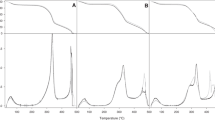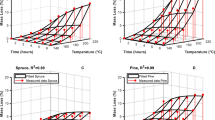Abstract
The kinetics of heat treatment as well as its effect on some physical and mechanical properties of poplar wood (Populus alba L.) were analysed in this research. Kinetic tests were performed at different treatment temperatures and two different air ventilation settings [low and high air exchange rate (AER) with the exterior]. The treatment kinetics was studied, starting from the oven-dry condition, according to the mass loss during time. The time–temperature equivalency was checked, the mass loss versus time formalised through a master curve. The analysis clearly showed how the heat treatment at low and high AER presents different degradation kinetics even if similar activation energy values were found. Some physical and mechanical properties of wood after treatments up to a mass loss of 7 and 10 % starting from oven-dry or standard environmental conditions state were also studied. All of the treated samples showed statistically significant differences compared to the untreated one. The treatments performed at 7 or 10 % of dry mass loss showed homogeneous behaviour. The same tendency was observed for the treatments starting at oven-dry or standard environmental conditions with the exception of Young’s modulus, which resulted in smaller reductions in wet starting condition when compared to dry samples.





Similar content being viewed by others
References
Agrawal RK (1985) On the use of the Arrhenius equation to describe cellulose and wood pyrolysis. Thermochim Acta 91:343–349
Airey GD (1997) Rheological characteristics of polymer modified and aged bitumens. PhD Thesis, University of Nottingham
Airey GD (2002) Road materials and pavement design use of black diagrams to identify inconsistencies in rheological data use of black diagrams to identify inconsistencies in rheological data. Road Mater Pavement Des 3:403–424
Alfrey T (1948) Mechanical behaviour of high polymers. Interscience, New York
Bächle H, Zimmer B, Windeisen E, Wegener G (2010) Evaluation of thermally modified beech and spruce wood and their properties by FT-NIR spectroscopy. Wood Sci Technol 44:421–433
Bansa H (2002) Accelerated ageing of paper: some ideas on its practical benefit. Restaurator 23:106–117
Bardet S, Gril J (2002) Modelling the transverse viscoelasticity of green wood using a combination of two parabolic elements. Comptes Rendus Mécanique 330:549–556
Bekhta P, Niemz P (2003) Effect of high temperature on the change in color, dimensional stability and mechanical properties of spruce wood. Holzforschung 57:539–546
Boonstra MJ, Rijsdijk JF, Sander C, Kegel E, Tjeerdsma BF, Militz H, Van Acker J, Stevens M (2006a) Microstructural and physical aspects of heat treated wood. Part 2. Hardwoods. Maderas Cencia y Tecnol 8:209–217
Boonstra MJ, Rijsdijk JF, Sander C, Kegel E, Tjeerdsma BF, Militz H, Van Acker J, Stevens M (2006b) Microstructural and physical aspects of heat treated wood. Part 1. Softwoods. Maderas Cencia y Tecnol 8:193–208
Brebu M, Vasile C (2010) Thermal degradation of lignin: a review. Cellul Chem Technol 44:353–363
Brown DJ (1982) The questionable use of the Arrhenius equation to describe cellulose and wood pyrolysis. Thermochim Acta 54:377–379
Calver A, Holbrook A, Thickett D, Weintraub S (2005) Simple methods to measure air exchange rates and detect leaks in display and storage enclosures. In: ICOM committee for conservation 2005—14th triennial meeting. ICOM, pp 597–609
Calvini P, Gorassini A, Merlani AL (2008) On the kinetics of cellulose degradation: looking beyond the pseudo zero order rate equation. Cellulose 15:193–203
Chai CK, Mccrum NG (1980) Mechanism of physical aging in crystalline polymers. Polymer 21:706–712
Cole KS, Cole RH (1941) Dispersion and absorption in dielectrics I. Alternating current characteristics. J Chem Phys 9:341
Dlouha J, Clair B, Arnould O et al (2009) On the time–temperature equivalency in green wood : characterisation of viscoelastic properties in longitudinal direction. Holzforschung 63:327–333
Edvardsen K, Sandland KM (1999) Increased drying temperature: its influence on the dimensional stability of wood. Holz Roh Werkst 57:207–209
Emsley AM, Stevens GC (1994) Kinetics and mechanisms of the low-temperature degradation of cellulose. Cellulose 1:26–56
Esteves BM, Pereira HM (2009) Wood modification by heat treatment: a review. Bioresources 4:370–404
Finnish ThermoWood Association (2003) Thermowood handbook. Finnish ThermoWood Association, Helsinki
Gillen KT, Clough RL (1989) Time–temperature-dose rate superposition: a methodology for extrapolating accelerated radiation aging data to low dose rate conditions. Polym Degrad Stab 24:137–168
Herrera A, Soria S, de Araya C (1986) A kinetic study on the thermal decomposition of six hardwood species. Holr Roh Werkst 44:357–360
Hill C (2006) Wood modification. Chemical, thermal and other processes. Wiley, Chichester
Hill CAS, Ramsay J, Keating B et al (2011) The water vapour sorption properties of thermally modified and densified wood. J Mater Sci 47:3191–3197
Huet C (1967) Complex modulus and compliances representation in the arithmetic and logarithmic complex plans. Cah du Groupe Fr Rheol 5:237–258 (In French)
Hutchinson JM (1995) Physical aging of polymers. Prog Polym Sci 20:703–760
ISO standard 3133 (1975) Wood: determination of ultimate strength in static bending
ISO standard 3349 (1975) Wood: determination of modulus of elasticity in static bending
Johansson D (2005) Strength and colour response of solid wood to heat treatment. PhD Thesis, Luleå University of Technology
Johansson D (2006) Influences of drying on internal checking of spruce (Picea abies L.) heat-treated at 212 °C. Holzforschung 60(5):558–560
Kamdem DP, Pizzi A, Jermannaud A (2002) Durability of heat-treated wood. Holz Roh-Werkst 60:1–6
Matsuo M, Yokoyama M, Umemura K et al (2010) Color changes in wood during heating: kinetic analysis by applying a time-temperature superposition method. Appl Phys A 99:47–52
Matsuo M, Yokoyama M, Umemura K et al (2011) Aging of wood: analysis of color changes during natural aging and heat treatment. Holzforschung 65:361–368
Matsuo M, Umemura K, Kawai S (2012) Kinetic analysis of color changes in cellulose during heat treatment. J Wood Sci 58(2):113–119
Matsuo M, Umemura K, Kawai S (2014) Kinetic analysis of color changes in keyaki (Zelkova serrata) and sugi (Cryptomeria japonica) wood during heat treatment. J Wood Sci 60(1):12–20
Militz H (2002) Heat treatment technologies in Europe: scientific background and technological state-of-art. In: Enhancing durability lumber engineered wood Products. Kissimmee, Orlando, 11–13 Feb 2002
Navi P, Sandberg D (2012) Thermo-hydro-mechanical processing of wood. EPFL Press, Lausanne (CH)
Pétrissans A, Younsi R, Chaouch M et al (2014) Wood thermodegradation: experimental analysis and modeling of mass loss kinetics. Maderas Cienc Tecnol 16(2):133–148
Rapp AO (2001) Review on heat treatment of wood. European Thematic Network for Wood Modification, Hamburg
Sandberg D, Haller P, Navi P (2013) Thermo-hydro and thermo-hydro-mechanical wood processing: an opportunity for future environmentally friendly wood products. Wood Mater Sci Eng 8:64–88
Selli E, Beltrame PL, Testa G, Bonfatti AM, Rossi E, Seves A (1998) Kinetic studies on the accelerated aging of cellulosic materials. Die Angew Makromol Chem 257:63–69
Sinha A, Nairn JA, Gupta R (2011) Thermal degradation of bending strength of plywood and oriented strand board: a kinetics approach. Wood Sci Technol 45(2):315–330
Stamm AJ (1956) Thermal degradation of wood cellulose. Ind Eng Chem 48:413–417
Stamm AJ, Tarkow H (1947) Dimensional stabilization of wood. J Phys Colloid Chem 51:493–505
Ströfer-Hua E (1990) Experimental measurement: interpreting extrapolation and prediction by accelerated aging. Restaurator 11:254–266
Struik LCE (1978) Physical ageing in amorphous polymers and other materials. PhD Thesis, University of Delft
Tjeerdsma BF, Militz H (2005) Chemical changes in hydrothermal treated wood: FTIR analysis of combined hydrothermal and dry heat-treated wood. Holz Roh-Werkst 63:102–111
Todaro L, Zanuttini R, Scopa A, Moretti N (2011) Influence of combined hydro-thermal treatments on selected properties of Turkey oak (Quercus cerris L.) wood. Wood Sci Technol 46:563–578
Xie Y, Fu Q, Wang Q, Xiao Z, Militz H (2013) Effects of chemical modification on the mechanical properties of wood. Eur J Wood Wood Prod 71:401–416
Zou X, Uesaka T, Gurnagul N (1996) Prediction of paper permanence by accelerated aging I. Kinetic analysis of the aging process. Cellulose 3:243–267
Acknowledgments
The authors acknowledge the financial support of Toscana Regional Administration with the POR CReO projects funding line as well as the European Union ERDF funding line. The authors would like to acknowledge Mr. Giacomo Del Bianco for his help in the measurement of physical and mechanical properties.
Author information
Authors and Affiliations
Corresponding author
Rights and permissions
About this article
Cite this article
Goli, G., Marcon, B. & Fioravanti, M. Poplar wood heat treatment: effect of air ventilation rate and initial moisture content on reaction kinetics, physical and mechanical properties. Wood Sci Technol 48, 1303–1316 (2014). https://doi.org/10.1007/s00226-014-0677-5
Received:
Published:
Issue Date:
DOI: https://doi.org/10.1007/s00226-014-0677-5




